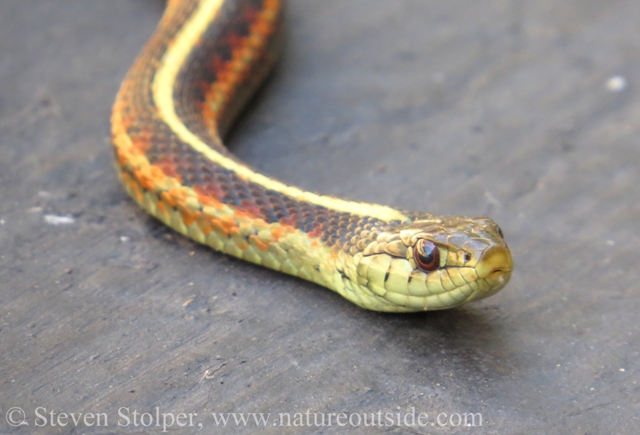
I Don’t Have the Time…
The most common complaint I hear from NatureOutside readers is that they don’t have time to go outside and explore. Family, work, and other obligations claim all their spare time.
The Urban Creatures and Bushcraft at Home series of articles help you explore your neighborhood and bring bushcraft into your home.
Find Your Local Garter Snake
Today we discuss the Garter Snake. It’s the most abundant and most widely distributed group of snakes in North America1. That’s why I’m sure there’s one living near you.
They have some clever survival strategies. In areas with severe winter they den underground below the frost line. These thermally safe dens are scarce, so communal denning is common. The snakes emerge in spring, mate, and then disperse to hunt.
Garter snakes give birth to live young (ovoviviparous). So they don’t need to find “good places” to incubate their eggs. They tend to be aquatic or like living near water. Their diet consists mainly of fish, amphibians, and insects. This might give you a clue where to find them.
Garter snakes have a defensive behavior of which you should be aware. If grabbed suddenly by a predator (or human hand!), they release a foul-smelling fluid and watery excrement. It’s not nearly as bad as a skunk, and most researchers who handle snakes generally ignore it. But it’s an unpleasant surprise if you’re wearing your best tuxedo. Either way, you shouldn’t handle wild snakes until you’ve received proper training so as not to harm them.
What do Garter Snakes Look Like?
In general, Garter snakes are slender, with keeled scales. Rather than being smooth, each scale has a ridge down the center that makes their skin rough to the touch.
Garter snakes usually sport a striped pattern. A wide pale stripe extends lengthwise from its head to the tip of its tail. Two thinner stripes run parallel, one on each side, low on its body. These stripes approximate the color of dried grass stems. They help conceal the snakes in the grassland habitats they prefer.
The scales between the strips can be uniform in color. Or they may show a blotched or checkered pattern. The combination of stripes and pattern look like a garter! This is how the snake came by its distinctive name1.
An Unexpected Visitor – The Coast Garter Snake
My most recent encounter with these amazing snakes occurred as I pulled into the driveway of my home. I don’t usually eat lunch at home when I’m working. But that day I needed to run some errands.
The 30” snake undulated across my driveway as I pulled in. It seemed to glow with yellow and orange fire as it crept out of the sunlight.
The snake was in no hurry as it meandered toward a bush growing next to my garage door. I guided my car around the reptile and then rushed back with my camera.
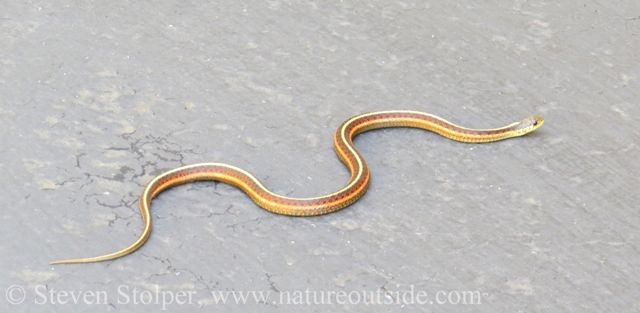
Coast Garter Snake (Thamnophis elegans terrestris)
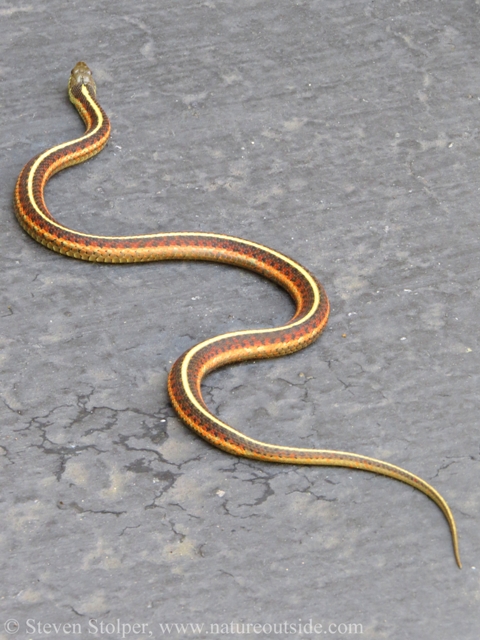
The snake seems to glow with yellow and orange fire as it creeps out of the sunlight.
It was a Coast Garter Snake (Thamnophis elegans terrestris)!
I wasn’t surprised to find it in the well irrigated landscape. A neighbor refused to go into her garden because of a surprise encounter with one of these snakes. It did no good to explain that the snakes were harmless. And that they were beneficial and helped to control pests. She was too traumatized by her sudden encounter.
Coast Garter Snakes survive so well in my surroundings because they are feeding generalists. They take advantage of any prey in the area. Where I live in California, this includes: Earthworms, slugs, snails, leaches, small fish, salamanders, frogs, toads, tadpoles, lizards, small snakes, rodents, shrews, birds, birds eggs, nestlings, and sometimes carrion. Some snakes in my area can even eat the deadly poisonous California Newt1 What a menu!
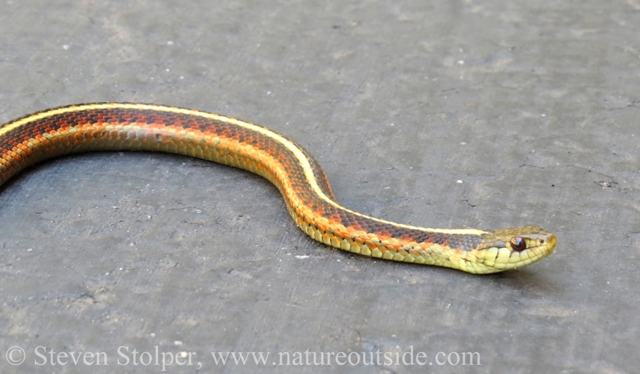
A better look at my visitor. Note the wide pale stripe along its back and the thinner yellow one on its side.
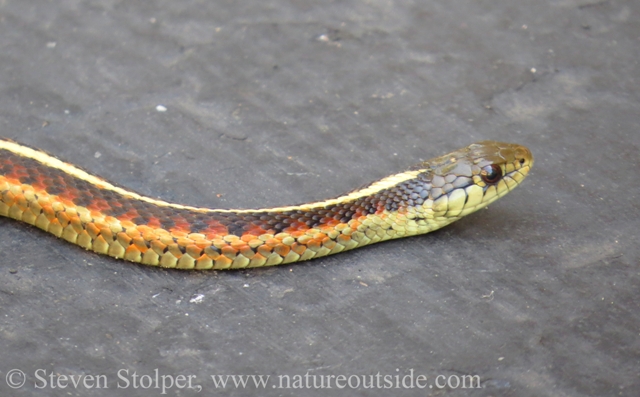
A closer look at this beautiful snake. It decides to remain motionless and see if I go away.
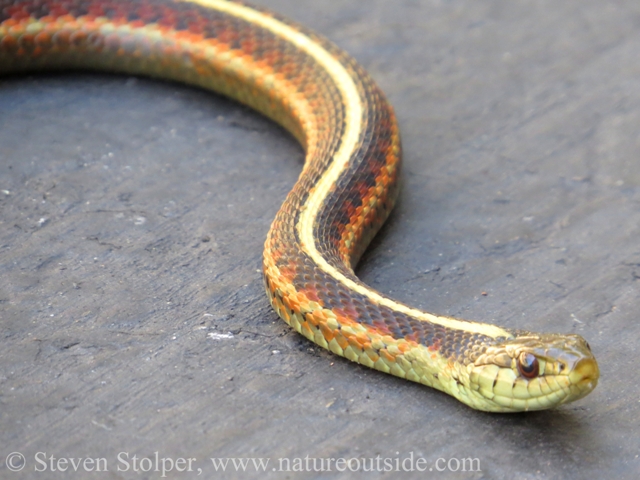
For a while it sampled the air with its tongue, trying to capture my scent. Then we just regarded each other. There is a patch of lighter scales along its side near the top-left of the picture. I don’t know enough about snakes to understand their significance.
An Endangered Species – The San Francisco Garter Snake
But not every Garter snake is so common. The San Francisco Garter Snake lives just miles from my door. And it’s an endangered species!
The San Francisco Garter Snake is a sight to behold. It’s a snake in designer colors! It has a striking red head, red dorsal stripe and pale blue side stripes . The snake is endemic to San Mateo County and the northern edge of Santa Cruz County, California. Because it’s only found in this limited area, and prefers feeding on amphibians, the San Francisco Garter Snake is endangered by human encroachment.
And the snake’s beauty works against it. The San Francisco Garter Snake is so beautiful and rare that poachers target it. Illegal collectors in the United States and Europe will pay hundreds of dollars for a specimen. Even though it is illegal to own one in the United States (criminal activities involving endangered species are punished with fines up to $50,000 and/or one year imprisonment).
But the outlook is not dismal. A small pond can support a healthy number of snakes. And agricultural ponds with frogs seem to help sustain them. Also, local and federal agencies actively monitor them and protect undeveloped habitat.
I saw a San Francisco Garter Snake on a recent hike. It was the first and maybe the last I will ever see. I wish I could have snapped some better pictures. But it declined to pose and disappeared into the tall marshy grass.
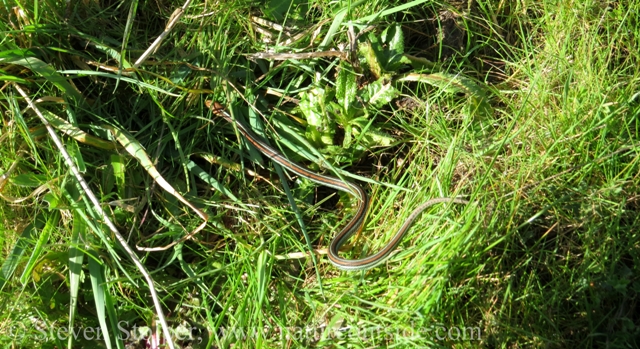
The endangered San Francisco Garter Snake (Thamnophis sirtalis tetrataenia). Have you ever seen an endangered Species?
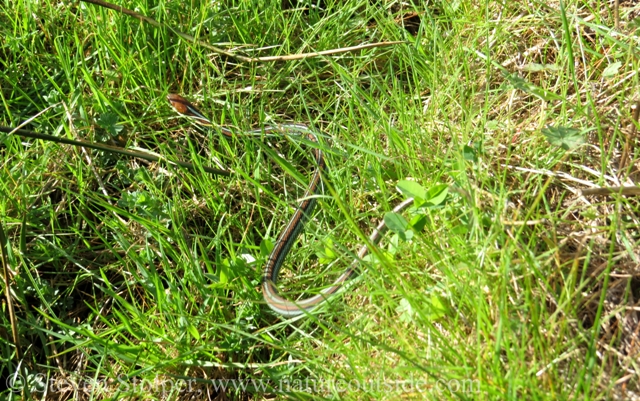
My pictures do not do justice to the startling red, black and pale blue colors. Notice the distinctive red-brown head.
My friends and I dutifully reported the sighting to the proper authorities. We were hiking in a protected area already known to harbor the species. So it wasn’t going to be front page news.
Look for Yours
So, I have a project for you: Learn about your local garter snake. Then see if you can spot one near your home. Don’t handle or harass it. Instead, take a picture and send it to me. If you do I will post it in this article.
References
The following is an affiliate link.
1Field Guide to Amphibians and Reptiles of California (California Natural History Guides)
Related Links on NatureOutside
Mountain Kingsnake – Beauty and Danger!
For fun facts and useful tips, join the free Bushcraft Newsletter.



Beautiful snake! When I was a kid (>10) my friend and I caught one in his garden. He kept it as a pet for a few years before letting it go. I wouldn’t recommend it, as wild animals have specific needs. I recall that little guy would try to shoot out the top of the aquarium whenever we opened the lid, earning him the name “Lightning”.
Thanks for sharing that story, Grindstone! When I was young, my father kept a pair of captive-bred garter snakes named Jack and Jill in his science classroom. It was the first time that I met these amazing creatures.
I agree with you about not collecting wild snakes. Today, I’m thrilled to see garter snakes in the wild. They always look so much more colorful out in their environment.
You Rock Steve, and a scientist too.
Thanks, Bob! I’m glad you enjoyed the article.